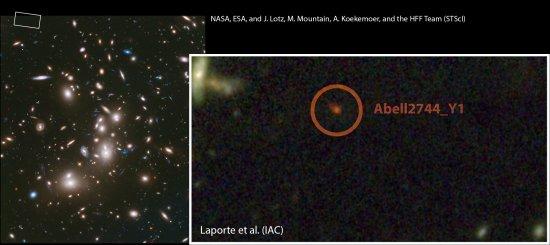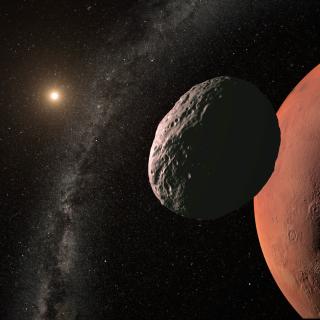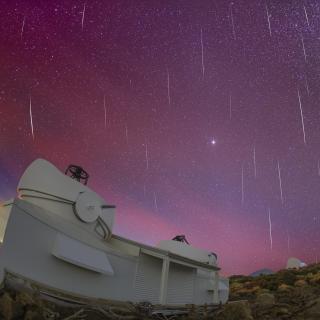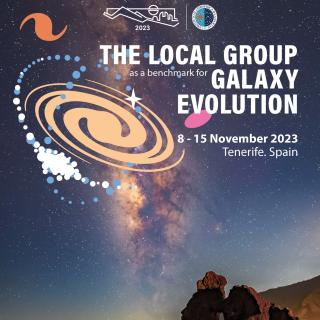Video at the end of the page
An international team led by astronomers from the Instituto de Astrofísica de Canarias (IAC) and La Laguna University (ULL) has just completed the first analysis of the observations of the Abell 2744 cluster of galaxies, a coordinated program of the Hubble and Spitzer Space Telescopes. The first result of this study is the discovery of one of the most distant galaxies known to date, which clearly shows the potential of the HST Frontier Fields project. These results will be published in the scientific journal Astronomy and Astrophysics Letters.
This work involves also researchers from France (Institut de Recherche en Astrophysique et Planétologie de Toulouse and Centre de Recherche Astrophysique de Lyon), Switzerland (Geneva University and Ecole Polytechnique Federal de Lausanne), and United States (University of Arizona).
Thanks to the high data quality of the Hubble (in the optical and near-infrared) and Spitzer (infrared) data, these astrophysicists have determined the properties of this young galaxy with a better precision than previous studies of other samples at similar cosmic epochs. This galaxy, named Abell2744_Y1, is about 30 times smaller than our Galaxy, the Milky Way, but is producing at least 10 times more stars. From the Earth, this object is seen as she was 650 million years after the Big-Bang. Her light has travelled about 13000 million years to reach the telescopes, being one of the brightest galaxies discovered at such distances. In Astronomy, the further one object is, the longer it takes for the light to reach us, and therefore the Frontier Fields allow the astronomers to push the limits of the observable Universe. This study provides new constraints on the density and properties of the galaxies in the early Universe.
“Frontier Fields”
Last month, during the meeting of the American Astronomical Society held at Washington D.C. (USA), the Space Telescope Science Institute presented its flagship project for the next 3 years: the “Hubble Frontier Fields". In the framework of this program, three of the most powerful space telescopes to date - Hubble, Spitzer and Chandra - will dedicate a large amount of their observing time to observe six galaxies clusters, who act as additional lenses and amplify the light from background sources, including very faint galaxies to the edge of the observable Universe. This will allow astronomers to study for the first time fainter and smaller galaxies in the first billion years of the Universe.
The first long exposure image of the cluster Abell 2744, obtained in the last months, is the deepest one obtained so far of a cluster of galaxies and is comparable to the previous Hubble Ultra Deep Field, which is a blank region of the sky. All the Frontier Fields clusters have been carefully selected and are the best ones for this kind of study.
Thanks to the gravitational lensing by the cluster, the light of the background galaxies can be magnified by a large amount. This effect converts in practice the Hubble Space Telescope into an equivalent telescope with a collecting area several hundred times larger.
Nicolas Laporte, post-doctoral researcher at the IAC and expert in the search for very distant galaxies, welcomes the high quality of the Hubble images: “we expected to find very distant galaxies close to the cluster core, where the light amplification is maximum. However, this galaxy is very close to the edge of the Hubble image where the light is not strongly amplified. We are really lucky that we could find it in the small field of view of Hubble. In a related study led by Hakim Atek (EPFL, Lausanne) more galaxies are analyzed but none is more distant than Abell2744_Y1.”
The analysis of the observations of this cluster carried out with the Spitzer Space Telescope has been crucial to estimate the properties of Abell2744_Y1. Alina Streblyanska, post-doctoral researcher at the IAC, comments that the Spitzer observations combined with the Hubble ones provide a good estimate of the distance to this galaxy. “They also suggest that Abell2744_Y1 contains not only stars but also a large amount of gas”.
Ismael Pérez-Fournon, professor at the La Laguna University and head of the IAC group, points out that last year his group contributed to the discovery of an exceptional star factory in the early Universe, called HFLS3, with the Herschel Space Observatory. “HFLS3 has extreme properties in the far-infrared, observed 880 million years after the Big-Bang. Abell2744_Y1 is a smaller galaxy, less massive but more distant and much more representative of the early Universe. Both types of galaxies are equally important to understand how galaxies formed and evolved.”
In coordination with the Hubble observations, the Spitzer Space Telescope and Chandra X-ray Observatory are taking very deep exposures of the Frontier Fields. Since the end of 2013, the data of the first cluster obtained by the first two telescopes are available to the whole scientific community.
Observations of the Frontier Fields by Hubble, Spitzer and Chandra are in an early stage but have already shown the exceptional potential of this new project to study the first luminous objects in the Universe. As it happnened with other Hubble initiatives on deep fields, many other observatories all over the world and in space will join the effort with additional observations of the Frontier Fields. An unprecedented scientific legacy for future studies with the present large telescopes as the Gran Telescopio Canarias (GTC), and the future extremely large telescopes as the E-ELT and the James Webb Space Telescope, is expected.
Publications:
- "The first Frontier Fields cluster: 4.5 micron excess in a z ~ 8 galaxy candidate in Abell 2744" N. Laporte, N. et al. 2014, A&A, 562, L8 (February 2014)
- Probing the z>6 Universe with the first Hubble Frontier Fields cluster Abell 2744 H. Atek et al., arXiv1311.7670
More information on the Hubble Frontier Fields: Hubble Space Telescope Frontier Fields
Contacts:
- Nicolas Laporte: (nlaporte [at] iac.es (nlaporte[at]iac[dot]es)) (+34) 922 605 752
- Ismael Pérez-Fournon: (ipf [at] iac.es (ipf[at]iac[dot]es)) (+34) 922 605 257
- Alina Streblyanska: (alina [at] iac.es (alina[at]iac[dot]es)) (+34) 922 605 746
Vídeo / Preview:
Title: Abell2744_Y1 galaxy
Description: Abell2744_Y1 is of the most distant galaxies in the early Universe discovered in the Hubble Frontier Fields.
Credit: Gabriel Pérez – SMM (IAC)
Related links:



